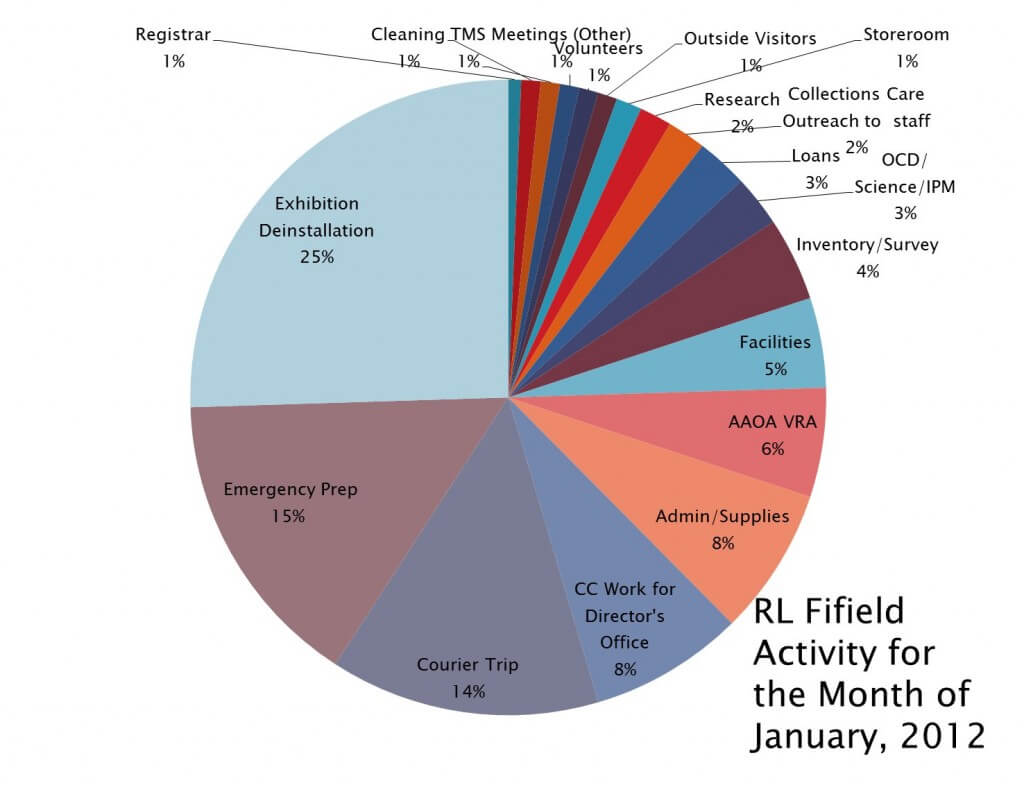Nope, I’m not a curator; I’m a collections manager. Many visitors who stop me in the galleries try to demonstrate their museum savvy by asking “Are you the curator?” I take a moment to educate them about the various roles required in a large museum.
A collections manager oversees long-term preservation for collections. We can get caught up in the laundry list of activities we perform on a daily basis: environmental monitoring, writing abandoned property summaries, emergency preparedness, shopping for archival supplies, performing collections care assessments, training volunteers, evaluating our documentation standards, preparing objects for loan and exhibition, travelling with objects we are lending to other museums – the list goes on. But when I lecture to students, I tell them to look at the big picture. What does a collections manager really do, in one sentence? We manage activities that promote preservation of physical and intellectual aspects of collections.
Preservation is pointless if we don’t let people see, learn, and develop their own appreciation of objects. Likewise, if we don’t balance that access to collections with preservation policy and activities, we lose the collection, preventing future access to it. And in order for a collection manager to do their job well, the institution must devote itself to a comprehensive and integrated collection care strategy.
A concise primer in collections-related museum positions:
- Curators collect relevant works for the collection and interpret those works through exhibition, publication, and other means.
- Conservators perform scientific research to develop appropriate treatment methods that are non-destructive and support the preservation of the object. Often, in smaller musuems, they also perform preventive conservation methods, such as a collections manager would do in larger museums.
- Collections managers are responsible for the planning and implementation of activities that ensures the long-term preservation outlook of the collection.
Are collections managers luxury items that only large museums can afford? They shouldn’t be. While many museums are more likely to create a conservator position before a collections manager position, a preventive approach to preservation of museum objects is critical: it is vital that we prevent damage, rather than fix damage. Conservation labs can often get more funding as the science and technology are intriguing to donors. However, if that vase they are trying to mend was broken when sent on loan, better packing and handling methods could have prevented that damage. If conservators are trying to fill in insect damage in order to stabilize an object, perhaps a program of Integrated Pest Management could have prevented that damage in the first place. As in medicine, prevention is always cheaper than treatment. And as it has been said in preventive conservation circles, no conservation treatment can repair authenticity.



[…] folks: What is a collections manager? (I’m glad I wrote that post, because it seems to have filled a need) Heritage Preservation […]
[…] Museum Monday – What is a Collections Manager? […]
[…] Museum Monday – What is a Collections Manager? […]
I see you’ve included an image of “Care of Collections” by Simon Knell. Do you have any other book recommendations for a brand new Collections Manager.
Hi Whitney – Depending on your responsibilities, I have a number of recommendations. An excellent series is Storage of Natural History Collections. Don’t let the title fool you – they are excellent volumes for all types of collections. Before I get you too excited, the overall volume on care of collections is currently out of print (I think) but it is being edited and will be available before too long. The second volume, which held designs for storage mounts, is now available at stashc.com. If you need registration assistance, pick up the latest copy of Museum Registration Methods, colloquially known as MRM5. And if you don’t have legal counsel in your institution, a copy of the Legal and Ethical Primer to Managing Collections is a must-have (get one anyway). Online, check out Connecting to Collections (http://connectingtocollections.org) for great webinars and links. Heritage Preservation (heritagepreservation.org) is a great site for emergency preparedness information. Your question has made me realize I should write a resources post! Best, Becky
Everything is very open with a clear description of the challenges.
It was really informative. Your website is extremely helpful.
Many thanks for sharing!